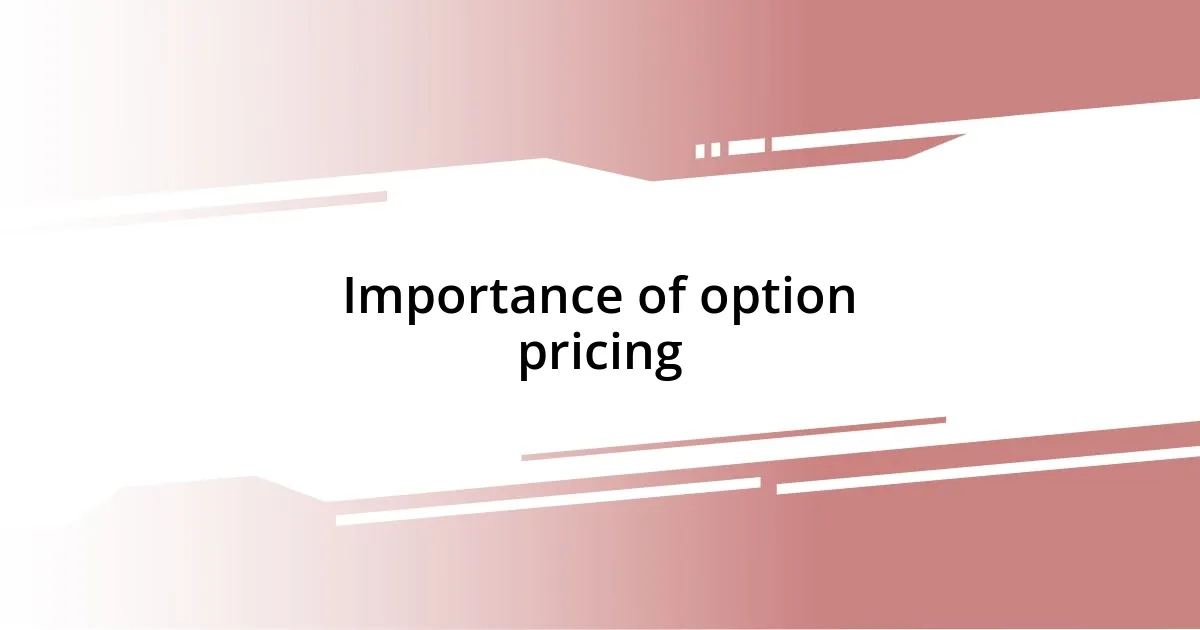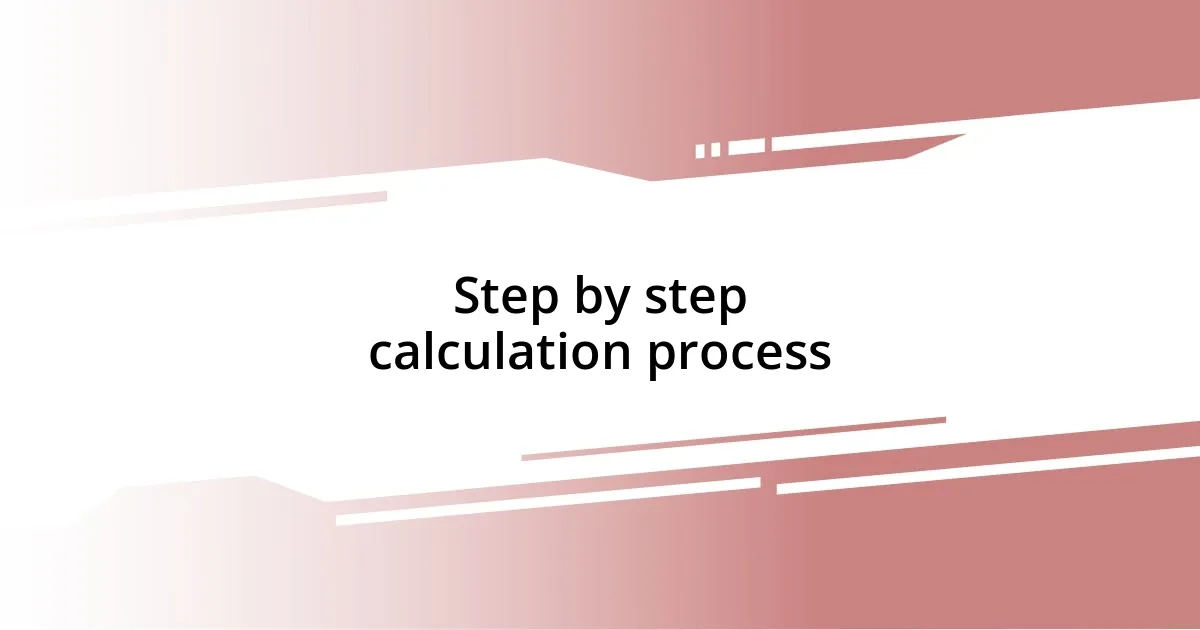Key takeaways:
- The Black-Scholes model revolutionized options pricing by allowing traders to quantify market volatility and assess potential outcomes.
- Precise option pricing is crucial for risk management, market efficiency, and informed investment strategies, significantly impacting trading decisions.
- Common pitfalls in using the Black-Scholes model include assuming constant volatility, overlooking transaction costs, and not accounting for dividends, highlighting the need for a comprehensive market understanding.

Understanding the Black-Scholes model
The Black-Scholes model is a cornerstone of financial theory that helps establish the pricing of options. Initially developed in the early 1970s by economists Fischer Black, Myron Scholes, and Robert Merton, the model introduces variables like underlying asset price, time to expiration, and volatility to calculate an option’s fair value. I still remember the first time I saw its equation on a whiteboard in finance class; it felt like unlocking a secret language that could predict potential outcomes in the options market.
One of the most fascinating aspects of the Black-Scholes model is how it transforms uncertainty into quantifiable insights. I often find myself pondering: how can something as intangible as market volatility be measured? The model achieves this by assuming that asset prices follow a lognormal distribution, which, although somewhat abstract, allows traders and investors a structured way to navigate the chaotic waters of the market. In my journey, this understanding has been pivotal; each time I apply it, I feel more empowered to make informed decisions.
What truly captivates me about the Black-Scholes model is its application in real-world scenarios. For instance, when I first calculated the price of a call option using the model, the thrill was palpable. It was as if the numbers came together to tell a story about potential profits and risks, bridging the gap between theory and practice. It’s a powerful reminder that behind every mathematical expression lies a world of opportunity waiting to be explored.

Importance of option pricing
Understanding the importance of option pricing can be a game-changer in trading strategies. I’ve seen firsthand how accurately pricing an option can lead to better risk management and informed investment decisions. When I first delved into options trading, I underestimated the significance of this element. It wasn’t until I faced a significant loss from a mispriced option that I realized its profound impact on the potential return.
The necessity of precise option pricing becomes clearer when considering its effects on market behavior. Here are some key points that illustrate its importance:
- Risk Assessment: It enables traders to evaluate the risk versus reward potential effectively.
- Market Efficiency: Proper pricing contributes to market efficiency by reflecting all available information in an asset’s price.
- Investment Strategy: Accurate option pricing helps shape informed investment strategies, allowing for better hedging and speculation.
- Volatility Insight: It provides insights into market volatility, aiding traders in understanding market sentiment.
- Performance Tracking: By tracking mispriced options, investors can identify potential profit opportunities overlooked by the market.
For me, mastering option pricing was not just about numbers; it transformed my outlook on trading. I remember a particular instance of successfully executing a complex options strategy, which was only possible due to my understanding of how to accurately price those options. That victory was more than just financial gain; it reinforced my confidence in navigating the intricacies of the market, firmly rooting my commitment to continuous learning in this field.

Step by step calculation process
To utilize the Black-Scholes model for option pricing, start by identifying the key inputs: the current stock price, the strike price, the risk-free interest rate, the time until expiration (in years), and the asset’s volatility. I vividly recall the first time I scoured financial data to gather these inputs. It was both exhilarating and anxiety-inducing, as I worked to understand how each component played a crucial role in shaping the final price.
Next, plug these values into the Black-Scholes formula. You’ll find it breaks down into two parts—calculating the d1 and d2 values, which serve as critical components for determining the option price. This step always reminds me of assembling a puzzle; you need every piece to see the full picture. Once completed, applying these values in the equations for call and put options feels like unveiling a fresh insight into the market.
Finally, after crunching the numbers, what really makes my heart race is interpreting the results. Seeing how external factors, like volatility and interest rates, shift the pricing brings an exhilarating dimension to trading. It’s a reminder that each calculation isn’t just a number—it’s a live reflection of market psychology. Embracing this process, rather than fearing it, has transformed the way I engage with financial markets.
| Input | Description |
|---|---|
| Current Stock Price (S) | Price of the underlying asset |
| Strike Price (K) | Price at which the option can be exercised |
| Risk-Free Interest Rate (r) | Returns on a risk-free investment (e.g., government bonds) |
| Time to Expiration (T) | Duration until the option expires, measured in years |
| Volatility (σ) | Measure of how much the asset price is expected to fluctuate |

Practical applications in trading
Using the Black-Scholes model in my trading practice provides practical advantages, particularly when making decisions about options. I often find myself at a crossroads, contemplating whether to buy or sell an option. It’s during these moments that I analyze the model’s output to assess the pricing and determine my potential return on investment. Have you ever experienced the tension of weighing your options? I remember one time looking at a call option that, according to the model, was undervalued. That insight encouraged me to jump in, resulting in a profitable position that might have slipped away had I not relied on the model’s calculations.
Another application that stands out for me revolves around hedging strategies. I often use the Black-Scholes model to evaluate my existing positions and ensure I’m adequately protected against market volatility. This became particularly vital during a recent market downturn. By accurately pricing my options, I could implement a hedge that not only minimized my losses but also provided an unexpected upside. Isn’t it fascinating how the model can act as a compass when navigating tumultuous waters?
Moreover, the model aids in spotting arbitrage opportunities that others might miss. With experience, I’ve become adept at identifying discrepancies between the market price of an option and its price as dictated by the Black-Scholes formula. The thrill of uncovering these moments is exhilarating; it’s like finding hidden treasures. For instance, I recall a scenario where I noticed a put option trading below its theoretical value. Acting swiftly, I bought in, ultimately profiting when the market corrected itself. These applications make me appreciate how the Black-Scholes model serves not merely as a theoretical exercise but as a practical tool that shapes my trading practice every day.

Common pitfalls and limitations
When diving into the Black-Scholes model, one common pitfall I’ve encountered is the assumption that volatility remains constant. Beginners, including myself at one point, often presume that the market’s mood doesn’t shift. I vividly recall a time when I neglected to properly account for increasing volatility during earnings season. The resulting mispricing of options nearly threw my strategy off course. Have you ever underestimated how quickly market sentiment can change? It’s humbling to realize that volatility can significantly influence outcomes.
Another limitation of the model that I’ve faced is its reliance on several idealized conditions. For instance, the Black-Scholes model assumes markets operate without friction, meaning no transaction costs or taxes, which is often a fantasy. I remember a specific trade where I confidently applied the model, only to later factor in commissions and fees that ate into my profits. It’s a reminder that real-world trading can be messier than mathematical models suggest. Have you found yourself overlooking costs associated with executing trades? It’s a tough lesson learned.
Finally, the model does not account for dividends, which can be impactful for options pricing. In a previous trade, I was caught off guard when a stock I held announced a dividend cut, affecting my anticipated returns. I had initially calculated everything based on the Black-Scholes framework, but neglecting this element made my projections skewed. It serves as a powerful reminder that while mathematical models can guide us, they must be paired with a comprehensive understanding of market nuances and external factors. How can we fully trust a model if we omit such critical information?














